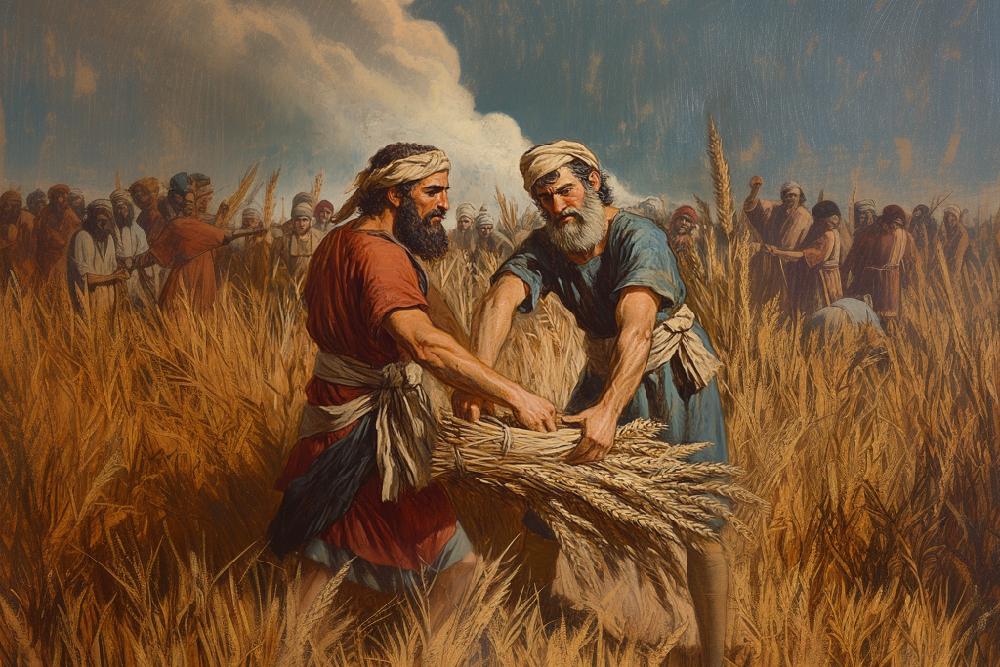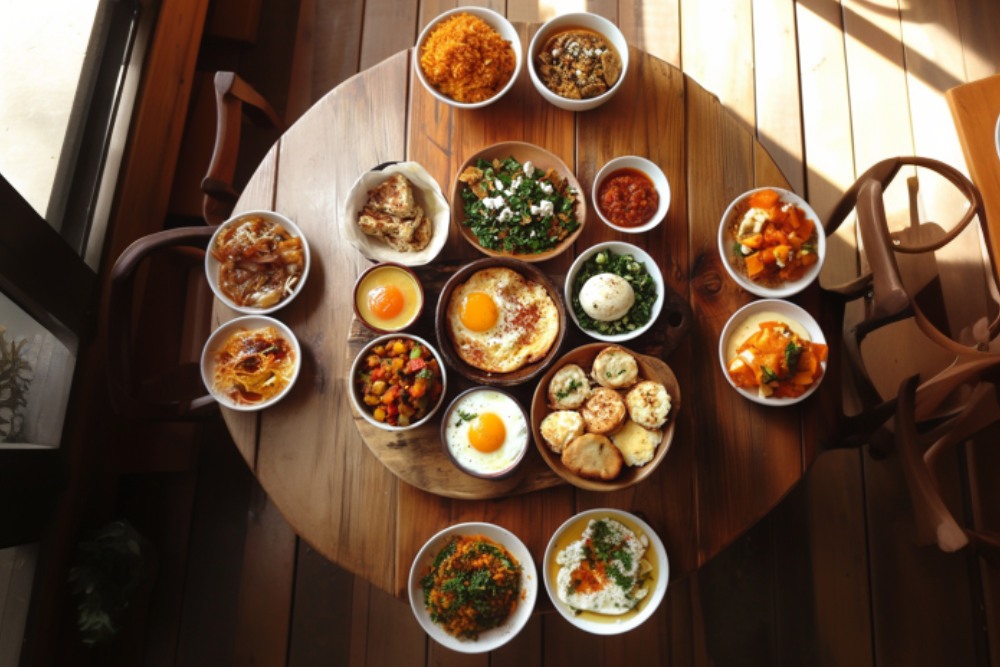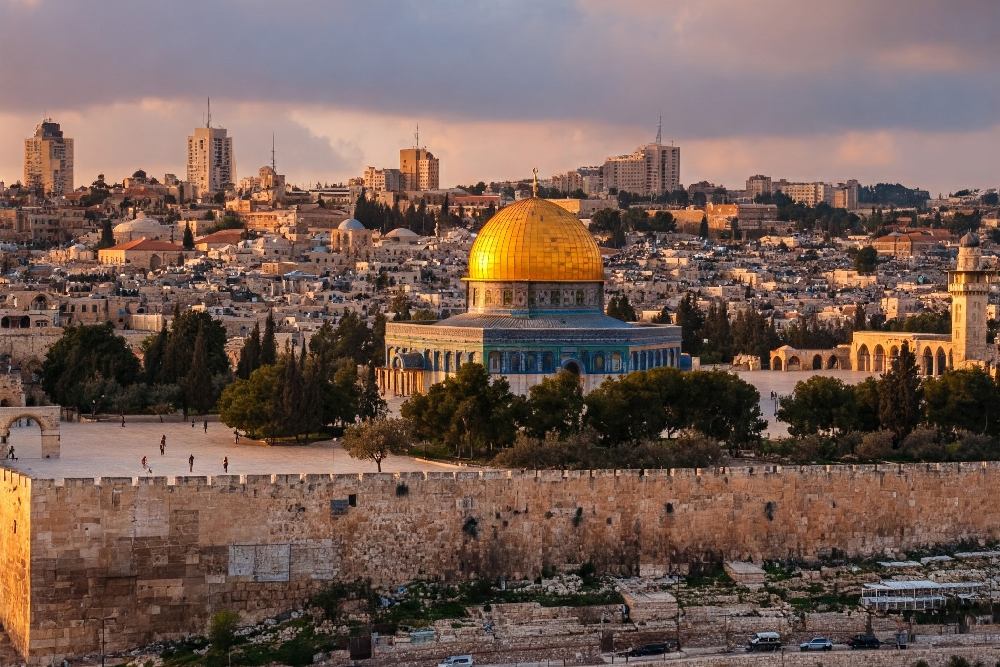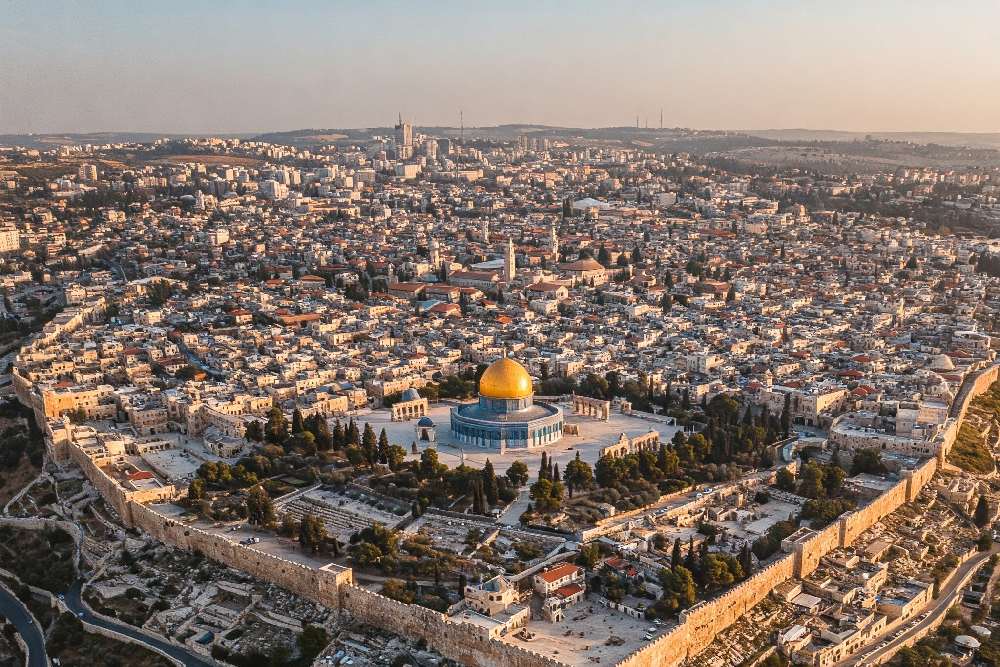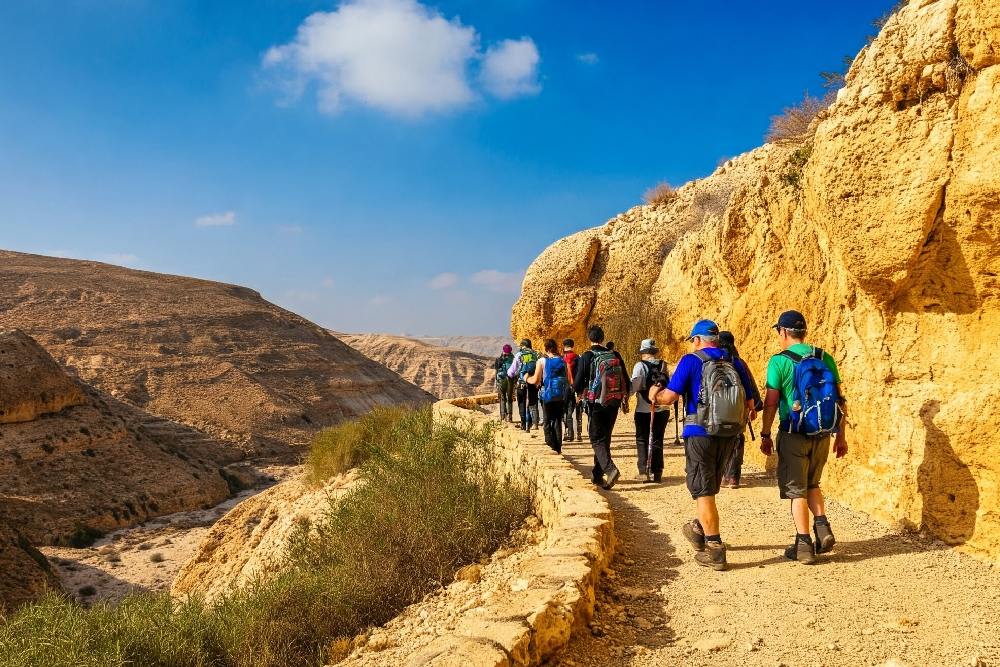
Hiking the Israel National Trail: A Journey Through the Ages
Are you tired of the same old tourist traps and crowded beaches? Do you crave an adventure that takes you beyond the typical sights and sounds into the very heart and soul of a country?
The Israel National Trail is a 1,000-kilometer (620-mile) hiking route. It's an epic trek through time where you'll visit biblical ruins, Crusader fortresses, vibrant modern cities, and the raw beauty of Israel's diverse natural wonders.
» Fuel your Israel National Trail adventure with authentic Israeli goods
What is the Israel National Trail?
The Israel National Trail is a unique hiking route crossing Israel from its northern border with Lebanon to Eilat in the south. Unlike trails focused solely on wilderness or pilgrimage, it blends modern and ancient history, cultural diversity, and varied landscapes.
Spanning approximately 1,100 kilometers, the trail begins at Kibbutz Dan and ends at the Red Sea. Its length varies as the Israel Trails Committee adjusts the route periodically. You experience diverse environments—deserts, forests, mountains, and urban areas. From the lush Galilee hills to the arid Negev Desert, you can travel through time and nature.
The trail traverses rocky mountains, fertile plains, and coastal areas, showcasing stunning views and diverse landscapes. You encounter forests, wadis, and urban environments, experiencing both natural beauty and human settlements. The southern section, with its dry, barren landscapes and limited water sources, also presents a particular challenge.
» Follow the footsteps of Jesus
Sites on the Israel National Trail
Mount Carmel
This mountain range in northern Israel is where the prophet Elijah confronted the prophets of Baal, as recounted in 1 Kings 18. Known for its lush forests and stunning Mediterranean views, Mount Carmel is a spiritual site for both Jews and Christians, with a monastery and other religious sites.
Mount Carmel Masada
This ancient fortress overlooking the Dead Sea is a UNESCO World Heritage Site and an iconic symbol of Jewish resistance against Roman rule in the 1st century. The ruins, including a palace, baths, and synagogues, stand as a testament to the struggles and triumphs of the Jewish people.
Mount Tabor
Rising 550 meters above sea level in Galilee, Mount Tabor is traditionally identified as the location of Jesus' Transfiguration (Matthew 17:1-9). It offers panoramic views and is a place of spiritual significance for Christians, with a mountaintop church that draws many pilgrims.
Qumran Caves
These caves near the Dead Sea are famous for the discovery of the Dead Sea Scrolls, ancient manuscripts that have significantly impacted our understanding of Jewish texts and religious practices.
The nearby Dead Sea, the lowest point on Earth, is mentioned in the Bible as a place of healing and rejuvenation. Its high salt concentration allows swimmers to effortlessly float on its surface.
Jerusalem
The holy city holds immense religious significance for Judaism, Christianity, and Islam. You can explore the historic Old City, home to the Western Wall, the Church of the Holy Sepulchre, and the Dome of the Rock. These landmarks represent key moments in biblical history and are central to the spiritual heritage of these three faiths.
Explore Our Handcrafted Products from Jerusalem:
Legends and Folklore:
The Israel National Trail is also interwoven with myths and legends that preserve the rich cultural heritage of the region.
Legend of the Cave of Zedekiah (Jerusalem): Legend tells that during the Babylonian siege of Jerusalem, King Zedekiah fled through this cave to Jericho. The spring inside is called "Zedekiah's Tears." The massive cavern, also known as Solomon's Quarries, is one of Jerusalem's most mysterious sites. Local folklore claims King Solomon mined stones here for the First Temple.Legend of Makhtesh Ramon (Ramon Crater): The trail passes through Makhtesh Ramon, the world's largest erosion crater. One legend describes it as the stomping ground of a giant, while another suggests it was formed by divine intervention. These myths are preserved through storytelling by local Bedouin tribes.The Story of Timna's Mushroom (Timna Park): Located in the southern Negev, Timna Park is famous for its geological formations, including "The Mushroom." Local Bedouin folklore tells of a mythical giant who accidentally dropped his meal here, which petrified into stone.
Festivals and Traditions:
Depending on the time of year, you may encounter various festivals and traditions along the trail.
Jewish Festivals: In the north, the Pomegranate Harvest Festivals celebrate the pomegranate, a fruit with biblical symbolism. These festivals include traditional music, dancing, and food fairs.Bedouin Hospitality Traditions (Negev Desert): In the south, you may experience Bedouin hospitality, such as being invited to share tea or meals in tents. This tradition reflects the Bedouin commitment to welcoming travelers in the harsh desert environment.
» Explore the most significant events in Jesus' life
Planning Your Hike on the Israel National Trail
When to Hike:
North to South: The best time to start is between October and December.South to North: Start in February or March.
Temperatures are most manageable between October and May, avoiding the extreme summer heat and the colder, wetter winter months. Late winter to early spring (March–May) offers milder temperatures and minimal rainfall.
But, flash floods in the desert can still occur, so checking weather updates is essential. This period is also the peak hiking season, so popular segments near Jerusalem or Tel Aviv may be crowded.
Fitness and Preparation
The Israel National Trail requires a moderate to high fitness level. You should be comfortable with:
Long days of walking (up to 20-25 km daily)Carrying heavy loads (15-20 kg)Navigating varied conditions, including heat and elevation changes
The remote desert sections in the Negev demand additional preparation due to limited water sources.
Essential Resources:
The Red Book guide for hikers offers day-by-day insights, including information about water sources.Websites like The Israel National Trail provide first-hand advice and services for water caching and other logistics.
Practical Tips:
Build Physical Stamina: Train at least three months before your trek. Incorporate hiking, running, or stair climbing to build endurance and leg strength. Practice with a loaded backpack to simulate trail conditions. Include hikes with elevation gain to prepare for mountainous sections.Plan for Water and Safety: In the Negev, pre-arrange water caching services with local experts. Carry at least 4 liters of water per day, plus an extra liter for emergencies. Bring a reliable map and compass, and download offline GPS apps.Gear and Environmental Readiness: Invest in lightweight, durable gear, including a tent, sleeping bag, and sturdy hiking boots. Check weather forecasts daily, especially in the desert, to avoid hazards like flash floods. Pack essentials like a first aid kit, sun protection, and a power bank. Ensure your gear fits comfortably.
Learn More About the Sites You’ll Visit (Or Pass By) on the Trail:
Are You Tough Enough to Hike the Trail?
Challenges on the Israel National Trail:
The Israel National Trail presents some unique challenges for you:
Water Scarcity: The Negev desert makes up a large part of the trail and has very few natural water sources. You need to plan ahead and either cache water along the way (using local services) or carry 4-6 liters each day. Not having enough water can lead to dangerous dehydration and heat exhaustion, especially in the warmer months.Navigation: Some areas, especially in the remote Negev desert, can be difficult to navigate. The landscapes are vast and lack distinctive features, and there aren't many signs. It's essential to carry a map, compass, and offline GPS device to stay on course, especially if you encounter bad weather or fog.Physical Demands: The trail includes steep climbs, rough paths, and long distances, which can be challenging in hot summer temperatures. You need to be in good physical condition and prepare beforehand by training for endurance and elevation gain.Wildlife: You might encounter snakes, scorpions, and insects, especially in the desert. Wear sturdy hiking boots, check your sleeping bag and gear regularly, and avoid camping in areas known for wildlife activity.
What to Pack:
Pack light but durable gear that can handle different terrains and weather conditions. Here are some essentials:
Backpack: A 50-70 liter backpack with a water bladder compartment.Shelter: A lightweight tent, sleeping bag (rated for cool nights), and sleeping pad.Clothing: Sturdy, broken-in hiking boots and moisture-wicking clothes.Sun Protection: A hat, sunscreen, and sunglasses.Water: A refillable water system that can hold 4-6 liters.Navigation: Maps, a compass, a GPS device, and a power bank for your electronics.Safety: A first aid kit, a multi-tool, and emergency supplies like a whistle and flashlight.
Resupply, Camping, and Lodging
The Israel National Trail offers several options for resupplying, camping, and finding lodging.
Resupply: You can find supplies in towns and kibbutzim along the trail, such as Tel Aviv, Arad, and Eilat. Many communities are hiker-friendly and have stores selling food and other essentials. It's a good idea to restock your food and water every few days.Camping: There are designated campsites, especially in national parks and forests. In the more remote desert areas, wild camping is permitted.Lodging: "Trail Angels" are locals who offer free or inexpensive lodging to hikers. They often provide beds, showers, and cooking facilities in their homes, kibbutzim, or farms. It's usually necessary to contact them in advance.
» Explore the majestic mountains of the Israeli Holy Land
Guided Hikes and Organized Tours
The Israel National Trail offers guided hikes and organized tours for everyone. Whether you prefer a multi-day trek with a group, a section-by-section journey, or a cultural immersion experience, there's an option for you.
Some companies provide full logistical support, taking care of transportation, accommodations, and meals. Others offer expert guides who can enhance your understanding of the trail's cultural, historical, and natural wonders.
Here are a few reputable companies offering guided hikes and tours:
Via Sabra: This company specializes in immersive experiences with expert guides who share their knowledge of the trail's cultural, historical, and environmental aspects. They offer a range of options, from self-guided hikes to fully supported trips with transportation and accommodations.Israel by Foot: This company focuses on flexible, section-by-section tours. They provide maps, GPS tools, and both self-guided and guided options to suit different preferences.APT Israel Private Tours: This company offers private tours that combine hiking with cultural immersion and historical insights. They include visits to key heritage sites, private guides, transportation, and accommodations.
Israel National Trail: Hike Through History
The Israel National Trail is a testament to the enduring spirit of Israel, where ancient history and modern life intertwine, and where the echoes of the past guide you towards a future filled with adventure and discovery.
So, pack your bags, lace up your boots, and embark on this extraordinary adventure. The Israel National Trail awaits, ready to unveil its secrets and leave an indelible mark on your soul.
Longing for a piece of the Holy Land but the Israel National Trail isn't calling your name? Bring the spirit of Israel to your doorstep with Artza. Our curated collection of handcrafted treasures, sourced directly from local artisans, allows you to experience the rich culture and heritage without leaving home.



